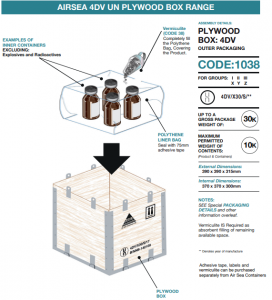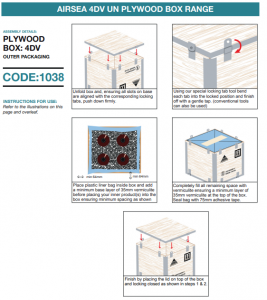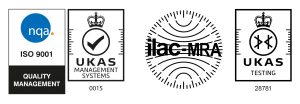How do you pack your 4DV box? Did you know incorrectly packing your 4DV box could result in invalidating the UN approval test certificate? Laurence Richards, Air Sea Container’s Product Manager discusses the common mistakes made by shippers when packing dangerous goods in 4DV plywood boxes.
Mistake 1: Using incorrect spacing of inners
4DV Plywood boxes can be used with various inners. During the testing process glass inners are used, once all regulatory tests are passed, the 4DV packaging is then approved for use with non-specific inners. This means that for 4DV you can use different inner packaging than those used during testing. Articles (like lithium batteries) can also be used in the plywood box assuming you stay within the weight allowance. However, there are minimum spacing requirements for placement of inners within the 4DV box in order for them to be sufficiently cushioned. For example, it isn’t simply a case of placing as many inners as possible into the 4DV box. Each accompanying assembly sheet or test certificate will advise you of the spacing required between your chosen inners.
Mistake 2: Incorrect weight limits of inners
The UN Recommendations on the Transport of Dangerous Goods Model Regulations (UNRTDG) states, for packagings intended to contain solids or inner packagings the number (stated on the UN specifications mark) is the number corresponding to the maximum gross mass in kilograms, at which the design type has been tested. In this example the ‘16’ in the UN Mark 4DV/X16/S/21/GB/5021 refers to the maximum gross mass in kilograms of the entire package (inners, substances and other accessories like cushioning materials).
When there is a letter “V” in the packaging code (4DV) this signifies a “Special Packaging”, UNRTDG regulations state one of the special packaging requirements relating to weight for “V” variants is, ‘the total combined gross mass of inner packagings shall not exceed one-half the gross mass of inner packaging used for the drop test’. This means only half the weight of the tested inners is allowed for that specific 4DV packaging design.
Shippers can refer to the test certificate or the assembly sheet that accompanies the packaging for its inner packaging weight allowances.
If shippers are unaware of this rule and inadvertently break this by filling the inners to more than half the tested weight, they would be in breach of the UN approval and could invalidate the certification.
Mistake 3: Any cushioning will do
Do you choose your preferred cushioning material for example, either vermiculite, polystyrene, newspaper, biodegradable chips or bubble wrap in your chosen 4DV Packaging?
Well unfortunately shippers aren’t allowed to choose their preferred cushioning type. Each UN approved packaging design has undergone rigorous testing in order for it to prove its capabilities and to gain UN certification, the cushioning you use when assembling your 4DV packaging must be the same cushioning type used in the approval tests. If it’s been tested with vermiculite, then you must use vermiculite. If alternative cushioning is used it may not provide the same protection as the approved with cushioning. Not only will it invalidate the UN certification but you also risk the inners and substances being compromised during transit. Again, shippers should consult the manufacturer’s assembly sheet to ascertain what cushioning should be used.
Mistake 4: Using the incorrect amount of cushioning material
To ensure that the inners and their content are suitably protected during transit, you must make sure that not only do you use the same cushioning material as per the test certificate, but you use a suitable quantity of the cushioning material in order to sufficiently secure and protect the inners from moving around within the 4DV box. Some cushioning types also act as the absorbent material hence the importance of ensuring you are using the recommended type and volume of cushioning. Usually, there is a minimum requirement of cushioning material for layering and spacing within the box. The assembly sheet will provide the shipper with information surrounding the quantity of cushioning material recommended for the 4DV box.
Image 1: Assembly sheet example for 4DV Plywood Box


How to avoid packing mistakes
Shippers must refer to the relevant model regulations to identify the packaging requirements and their responsibilities as a shipper when transporting dangerous goods.
However, compliance does not stop at identifying and purchasing suitable packaging. It is the shipper’s responsibility to ensure that they pack their substance/article correctly within the packaging. This is where the assembly sheet comes in. It is essential that the shipper packs the substance exactly as per the instructions on the assembly sheet, to ensure the chosen packaging performs to the standard it did during approval testing. If a shipper fails to pack the Dangerous Goods as per the assembly instructions, they risk compromising the capability of the packaging, meaning the packaging may not perform to the same standards it did during testing. This could result in, poorly protected inners, invalidation of the test certificate or in the event of a leakage / incident, cause harm to people, animals, property and the environment.
The following video demonstrates how to correctly package a 4DV box in line with the packaging’s assembly sheet.
Visit our 4DV Packaging page for more information on Plywood boxes or contact us today.
Information correct at time of publishing, 25th January 2021
 UK
UK


